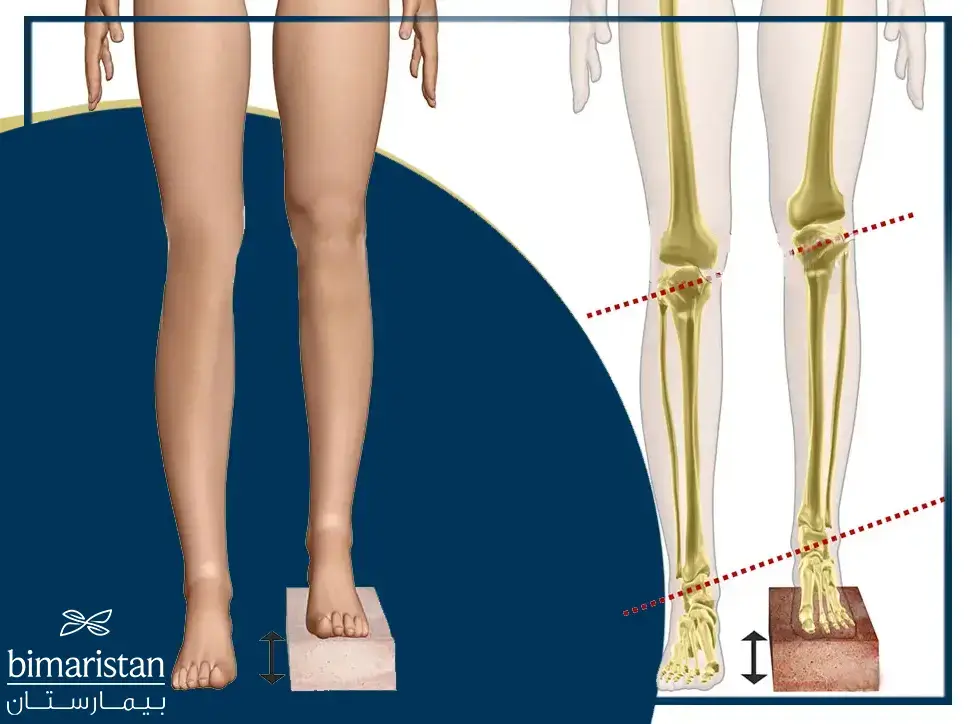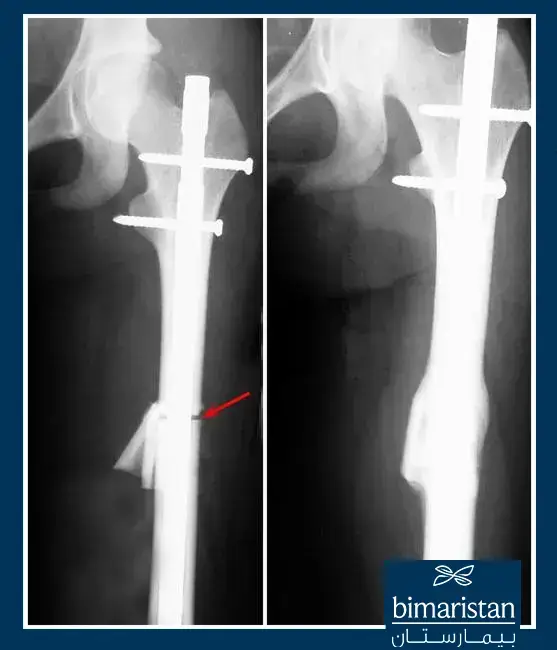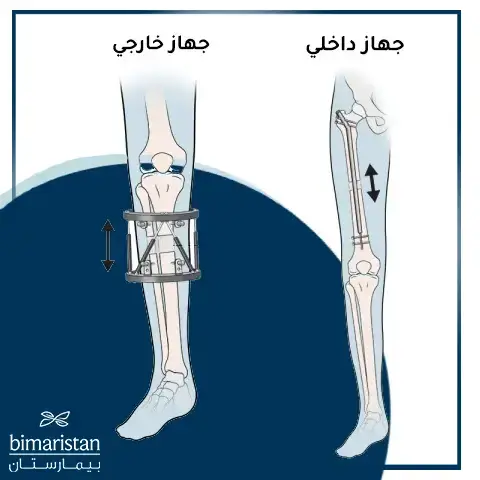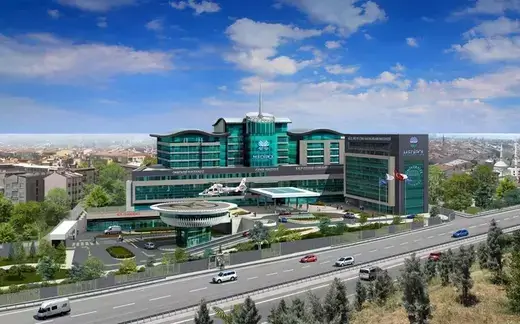اختلاف طول الساقين هو وجود ساق أطول من الأخرى بسبب اختلاف النمو العظمي، إذا كان لديك رجل أطول من رجل نقدم لك فرصة تصحيحها على يد أفضل الأطباء المختصين في تركيا.
يعتبر اختلاف طول الساقين Leg Length Discrepancy مشكلة حقيقية عند الإنسان تعيقه عن المشي وقد تسبب له مع الوقت أمراضاً مختلفة في الركبة والكاحل والعمود الفقري، بالإضافة إلى ميلان الكتفين وأذية في مفصل الورك بسبب المشية غير الطبيعية؛ لذلك فإن علاج هذه المشكلة ضروري كي يتمكن المريض من ممارسة حياته بشكل طبيعي.
قد لا تكون الجراحة هي الخيار الوحيد أمامك لحل مشكلة اختلاف طول الساقين، إذ يمكن التفكير بعلاجات أخرى غير جراحية مناسبة لحالتك. تابع معنا في هذا المقال لتتعرف على اختلاف طول الساقين وطريقة علاجه في تركيا بشكل مفصل.
لمحة عن اختلاف طول الساقين
يوجد اختلاف في طول الأطراف -سواء العلوية أو السفلية- عند العديد من البشر لكنها تكون طفيفة بحيث لا يمكن ملاحظتها، كما قد يكون اختلاف طول الساقين مشكلة أكبر من اختلاف طول الذراعين كونه أشد أعراضاً وتأثيراً على حياة المريض اليومية.
هنالك العديد من الأسباب التي تؤدي إلى اختلاف طول الساقين عند الأطفال. بأية حال، إذا كان فرق طول الساقين أقل من 2 سم -كما هو الحال عند الكثير من الناس- فلن يكون ظاهراً ولن يؤثر على الحياة بشكل كبير وسيكون علاجه بسيطاً.
ولكن في حال كان الفرق في طول الساقين أكثر من 2 سم سيواجه المريض مشكلة في حياته اليومية وخاصة أثناء المشي، فاختلاف طول الساقين فضلاً عن كونه مشكلة جمالية فهو مسبب رئيسي للعديد من الأمراض العظمية الأخرى مثل الجنف.
توجد العديد من الوسائل لعلاج فرق طول الساقين في تركيا، ولعل الجراحة من أبرزها نظراً للنتائج المُرضية التي حققتها لكثير من المرضى. تختلف تقنيات جراحة اختلاف طول الساقين والمعدات المستخدمة فيها تبعاً لحالة المريض ومدى تطلعاته لنتائج العلاج.

كيف أعرف أن لدي ساق أطول من ساق؟
تختلف أعراض اختلاف طول الساقين بحسب شدة هذا الاختلاف، فإذا كان الفرق في الطول كبيراً ستظهر الأعراض التالية بشكل واضح:
- العرج أثناء المشي؛ لأن أحد الوركين سيكون أعلى من الآخر، فإما أن تثني ركبة الساق الطويلة وإما أن تمشي على رؤوس أصابع الرجل القصيرة.
- ألم الظهر؛ وذلك بسبب طريقة المشي غير الطبيعية.
- التعب؛ نتيجة الجهد الزائد المبذول من أجل المشي.
ما أسباب رجل أطول من رجل؟
هنالك العديد من الأسباب لاختلاف طول الساقين Leg length discrepancy، لكنها تُقسم بشكل رئيسي إلى أربعة مجموعات تؤدي إلى توقف النمو العظمي في ساق مع بقاء الساق الأخرى طبيعية.
اختلاف طول الساقين الخلقي
قد يحصل توقف في نمو أحد الرجلين خلال المرحلة الجنينة لأسباب مجهولة، فيولد الطفل برجل أقصر من الأخرى بسبب عيب تطوري. يمكن أن تؤدي بعض المشاكل التوليدية أيضاً إلى تناقض طول الساقين كما في خلع الورك التطوري (الولادي) والورك الفحجاء Coxa Vara.
اختلاف طول الساقين الرضي
من أسباب اختلاف طول الرجلين أيضاً إصابة إحداهما بالكسور العظمية المعقدة التي لا تشفى بسهولة وخاصة في منطقة قرص النمو (غضروف النمو)؛ حيث يؤدي الكسر في هذه المنطقة إلى تعظمها الباكر فيتوقف نمو الساق، بينما تستمر الساق الأخرى بالنمو بشكل طبيعي.
نخص بالذكر هنا عظمي الفخذ والظنبوب (قصبة الساق) فقد يؤدي الكسر الشديد فيهما إلى توقف نموهما. مع العلم أن بعض كسور عظم الفخذ قد تؤدي إلى فرط نمو العظم وبالتالي زيادة في طول الساق المصابة.
اختلاف طول الساقين المرضي
يمكن لبعض الأمراض العظمية أن تؤدي إلى قصور في نمو العظم وبالتالي تناقص الطول العظمي في الطرف المصاب، ومنها:
- هشاشة العظام
- ذات العظم والنقي
- أورام العظام
- الكيسات العظمية
قد يكون اختلاف الطول بين الساقين ناجماً عن علاج هذه الأمراض أساساً -سواءً أكان العلاج بالاستئصال الجراحي أو بالأشعة أو بالأدوية الكيماوية- لأنها قد تؤدي إلى إبطاء أو إيقاف النمو العظمي.
أسباب أخرى
قد تسبب بعض الأمراض الأخرى ضعفاً في الطرف أو عدم القدرة على استعماله مسببةً قصوراً في نموه، بعضها الآخر يشكل التهاباً حول قرص النمو فيتعطل عمله ويحصل تناقض طول الساقين. من هذه الأمراض:
- الشلل الدماغي
- التهاب المفاصل الشبابي
علاج رجل أطول من رجل بدون جراحة
إذا كان فرق طول الساقين بسيطاً (أقل من 2 سم) فلا ينصح بالجراحة وتفضل عند ذلك الحلول غير الجراحية؛ لأن الفائدة من الجراحة قليلة مقارنةً مع المخاطر المتعلقة بإجرائها. يتضمن العلاج غير الجراحي:
العلاج الطبيعي
تعتمد المعالجة الفيزيائية على القيام بتمارين إِطالة وتمطيط للعضلات بهدف تقليص الفارق بين طول الساقين قليلاً. على كل حال، حتى تتحقق الفائدة العظمى من هذا العلاج يجب أن يُجرى تحت إشراف طبيب متخصص بالعلاج الطبيعي يحدد لك التمارين المناسبة لك بدقة.
تواصل معنا للاستفسار عن تفاصيل العلاج الطبيعي في تركيا.
دعامة الحذاء
بإمكانك التخلص من أعراض اختلاف طول الساقين ببساطة عبر وضع رافعة أو دعامة لحذائك في القدم القصيرة بحيث يكون ارتفاع هذه الدعامة مساوياً لفرق طول الساقين، سيقوم الطبيب بقياس طول ساقيك بدقة من أجل تصميم أحذية خاصة بك.
الأطراف الصناعية
قد يكون اختلاف طول ساقيك ناجماً عن مرض خطير في العظام يدفعك إلى بتر الطرف في نهاية المطاف، وهنا يكون الحل الوحيد عبر تركيب أطراف صناعية كي تعود إلى الحياة الطبيعية وتسير مجدداً على قدميك.
علاج رجل أطول من رجل عند الأطفال
يعتمد علاج اختلاف طول الساقين على سبب المشكلة وشدتها وعمر الطفل.
بعض خيارات العلاج تشمل:
- المراقبة: قد لا يتطلب الاختلاف الطفيف في طول الساقين أي علاج، خاصة إذا لم يُسبب أي أعراض.
- الأحذية الخاصة: يمكن استخدام أحذية مخصصة لرفع الساق الأقصر أو خفض الساق الأطول.
- تمارين العلاج الطبيعي: يمكن أن تساعد تمارين التمدد والقوة في تحسين نطاق الحركة وتقليل الألم.
- الجراحة: قد تكون الجراحة ضرورية في بعض الحالات، مثل حالات الاختلاف الشديد في طول الساقين أو وجود مشاكل في النمو.
علاج اختلاف طول الساقين جراحياً
توفر الجراحة العديد من الحلول العلاجية في حالات عديدة حيث تعيد الطرف إلى طوله الطبيعي وتحقق التساوي بين طول القدمين وذلك إما عبر تقصير الساق الطويلة أو تطويل الساق القصيرة. يتم اختيار الجراحة المناسبة في تركيا حسب عمر المريض وفرق الطول بين الساقين.
يقوم الطبيب بمناقشة المريض حول رغبته في كسب القليل من الطول أو خسارة بضع سنتيمترات من طوله كي تعود مشيته طبيعية.
عملية تقصير الساق في تركيا
تتميز هذه العملية بكونها بسيطة قليلة الاختلاطات على عكس عمليات تطويل الساق، لكن من مساوئها أنها تُفقد المريض بعض السنتيمترات من طوله.
يُلجأ إلى تقصير الساق عندما يكون اختلاف طول الساقين متوسطاً (2-6 سم)، تختلف جراحة تقصير الساق لشخص بالغ كامل النمو عن جراحة تقصير الساق لطفل في مرحلة النمو، لذلك فهي تُقسم إلى نوعين:
تقصير الساق عند الأطفال
بما أن الأطفال يكونون في مرحلة النمو وزيادة الطول فيمكن علاج اختلاف طول الساقين لديهم عبر إيقاف نمو العظام في الطرف الطبيعي حتى يتسنى للطرف القصير الالتحاق بطول الطرف الآخر وبالتالي تحقيق التوازن بين طول الساقين. هناك نوعان من العمليات الجراحية للأطفال:
- عملية تثبيت المشاش العظمي Epiphysiodesis: يقوم الجراح بإجراء التحام في مشاش العظام في الطرف الطويل لإيقافه عن النمو بشكل مؤقت أو دائم (التوقيت هنا هو العامل الأهم في نجاح هذا العلاج).
- عملية تدبيس المشاش العظمي Epiphyseal Stapling: يقوم الجراح بإدخال دبابيس في مشاش العظام في الساق الأطول لإيقافها عن النمو مؤقتاً ريثما تلحق الساق القصيرة بها ويصبحان بنفس الطول، عندها تزال الدبابيس.
تقصير الساق عند البالغين
بما أن نمو العظام يكون مكتملاً لدى البالغين فالحل الوحيد لعلاج رجل أطول من رجل هو إزالة جزء من العظم في الساق الطويلة بحيث يتساوى طول الساقين بعد التئام طرفي العظم.
اقرأ المزيد حول كيفية تسريع التئام العظام في تركيا.

عملية تطويل الساق في تركيا
تُجرى هذه العملية للمرضى بعمر المراهقة وبداية سن البلوغ وتقوم على مبدأ التئام الكسور في العظام؛ حيث يتم إزالة قطعة من العظم المراد إطالته ويوضع مكانها جهاز تطويل عظام خارجي أو داخلي.
يعتبر جهاز تطويل العظام الداخلي من أحدث تقنيات علاج اختلاف طول الساقين في تركيا بسبب دقته العالية وتخفيضه لخطر حدوث إنتان في عظام الساق بعد العملية.

بعد تركيب هذا الجهاز بعملية جراحية يوصى الطفل (أو أحد أفراد أسرته) يومياً بتدوير ذراع صغيرة موضوعة على الساق ومتصلة بالجهاز داخل العظم من أجل تعديل طول الجهاز الموضوع بين هاتين القطعتين وزيادة البعد بين قطعتي العظم. يتم نزع الجهاز بعملية جراحية أخرى بعد أن يُشفى المريض من اختلاف طول الساقين.
تعتبر عملية تطويل العظام من أطول العمليات الجراحية فهي تستمر لعدة أشهر؛ وذلك لأن بناء العظم يتم بشكل بطيء جداً، وبالتالي فإن الزيادة اليومية في الطول لا تتعدى بضع مليمترات حتى نصل إلى الطول المطلوب.
سابقاً كان علاج اختلاف الطول بين الساقين صعباً وغير ممكن، أما الآن يوفر مركز بيمارستان الطبي أحدث الوسائل العلاجية بهدف استعادة التوازن الطبيعي للمريض. يتم علاج فرق طول الساقين في تركيا بعد النظر في حالة المريض ورغباته وتطلعاته بالإضافة إلى توصيات الطبيب المختص. تواصل معنا للحصول على استشارة طبية مجانية من قِبل أطباء مختصين والسعي نحو حياة أفضل.
المصادر:








